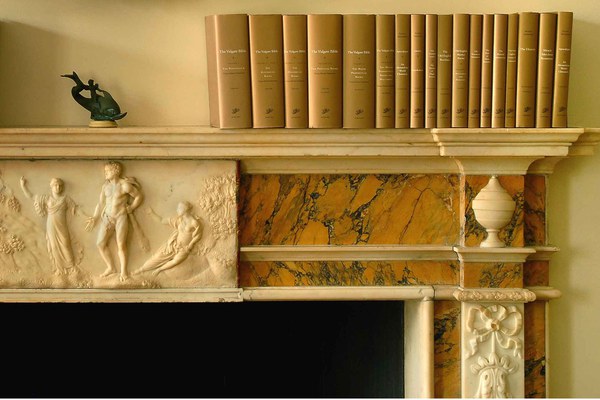Dumbarton Oaks’ 2018 Kalamazoo programming got off to a tremendous start with a session cosponsored by the Dumbarton Oaks Medieval Library (DOML) and Platinum Latin, the community of late antique and medieval Latinists based at Universität Wien. “Encountering Muhammad in the Medieval West” drew a standing-room-only crowd, with audience members seated in the aisles and standing along the back wall to hear papers by Jessalynn Bird of Saint Mary’s College, Notre Dame, and Julian Yolles of Harvard University. The session was organized by DOML’s Medieval Latin editor, Univ.-Prof. Dr. Danuta Shanzer of Universität Wien, and by Gregory Hays, associate professor of Classics at the University of Virginia and a member of DOML’s medieval Latin editorial board.
The session was inspired by Medieval Latin Lives of Muhammad, a collection of biographies of Muhammad written by Christian authors from the ninth through thirteenth centuries, edited and translated by Julian Yolles and Jessica Weiss and published this May by Harvard University Press (Dumbarton Oaks Medieval Library 51). As Bird and Yolles explained, stories about the prophet not only satisfied the curiosity of Westerners about the foundation of an important and rival religious tradition, but also, by drawing on the tropes and techniques of polemics against Christian heresies, placed that tradition in a familiar framework for the defense of the faith and bolstered the Christian case for the Crusades. One frequent detail mentioned by Latin writers was the identification of Muhammad’s visions, which brought him messages from the Archangel Gabriel, as symptoms of epilepsy. By attributing the visions to this cause, Latin writers could rationalize his prophecies as natural or even demonic in origin, taint them with the negative associations attributed to epilepsy in the period, and even call into question the prophet’s moral character by suggesting his religious career was founded on nothing more than a desire to explain away a potentially embarrassing disease to his skeptical newlywed wife.
This successful session was followed by “Teaching with Translations,” sponsored by the Dumbarton Oaks Medieval Library, organized by DOML Old English Editor Daniel Donoghue, of Harvard University, and featuring papers from Michael R. Kightley of the University of Louisiana–Lafayette and Jay Gates of the John Jay College of Criminal Justice, CUNY. One of the challenges of teaching medieval texts in the classroom is access—students, especially at the undergraduate level, rarely have the specialist training required to study texts in their original language, meaning that for most students, their encounters with medieval books are entirely through translations. Teachers of medieval literature, therefore, face the choice either of concealing the necessary distance this erects between student and text, or, as Kightley and Gates advocated in reflecting on methods for teaching Beowulf, of embracing the problem in order to highlight the ways that great texts generate multiple and multiplying interpretations.
Kightley presented a variety of exercises he uses in his own classroom in which he supplements a passage from the assigned class translation with sample passages from other translations. Comparison between multiple translations, he explained, can show the profound impact a translator’s priorities and cultural moment can have on a work. Doing this, he suggested, can free us from the trap of viewing translations on a spectrum running from the “literal” to the “artistic,” measured in absolute distance from the original.
No translation, however literal, can convey the full nuance of another language, or wholly avoid adding anything new to a text, any more than an “artistic” translation ought to be dismissed without exploring what it captures of both the spirit and letter of the text. Likewise, Gates explained how he uses Dumbarton Oaks Medieval Library’s own The Beowulf Manuscript, edited and translated by R. D. Fulk, in conjunction with imagery from the Beowulf manuscript itself to demonstrate how the “original text” in a printed book is just as much a modern interpretation of a medieval text as the modern translation is. By including the manuscript’s other, less familiar texts alongside the famous epic, The Beowulf Manuscript helps teachers to bring the poem’s manuscript context into the classroom in a natural and approachable way. Seeing manuscript and modern book side-by-side makes visible the contrast between the unimpressive medieval presentation of the poem and its outsize modern reputation, and reveals how, by transforming the text into something more legible to our modern eyes, editors have created a new work that would be all but unrecognizable to its medieval readers.

